Depression in the Workplace: A Comprehensive Report
VerifiedAdded on 2023/01/11
|9
|2695
|31
Report
AI Summary
This report provides a comprehensive overview of depression, specifically focusing on its impact within the workplace. It begins by defining depression as a common mental disorder and highlighting its significant impact on individual health, absenteeism, and productivity. The report explores various causes of workplace depression, including work pressure, negative work environments, and bullying. It details key symptoms such as fatigue, loss of interest, and suicidal thoughts, alongside diagnostic methods and the burden depression places on the economy, society, and organizations. The methodology involves qualitative research, using search terms related to depression, workplace, and treatment. The case study focuses on the working population aged 25-50 years, outlining treatment options like cognitive behavioral therapy, psychodynamic therapies, and pharmacological treatments. The report concludes by emphasizing the importance of addressing workplace depression through various interventions and treatments, highlighting the need for a supportive work environment and early intervention strategies. It also discusses the impact of depression on different age groups and addresses the ethical considerations within the workplace. The study emphasizes the importance of understanding depression in the workplace.
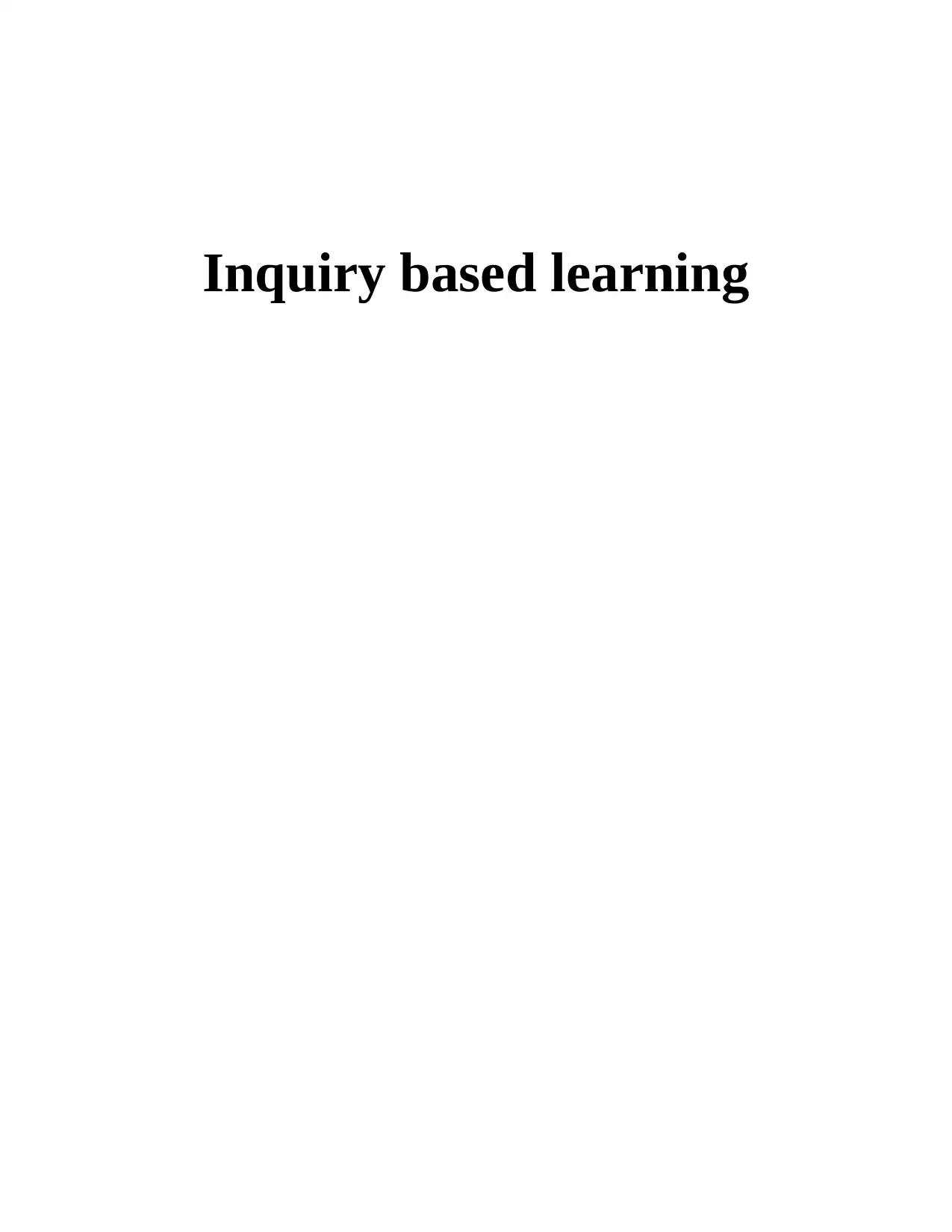
Inquiry based learning
Paraphrase This Document
Need a fresh take? Get an instant paraphrase of this document with our AI Paraphraser
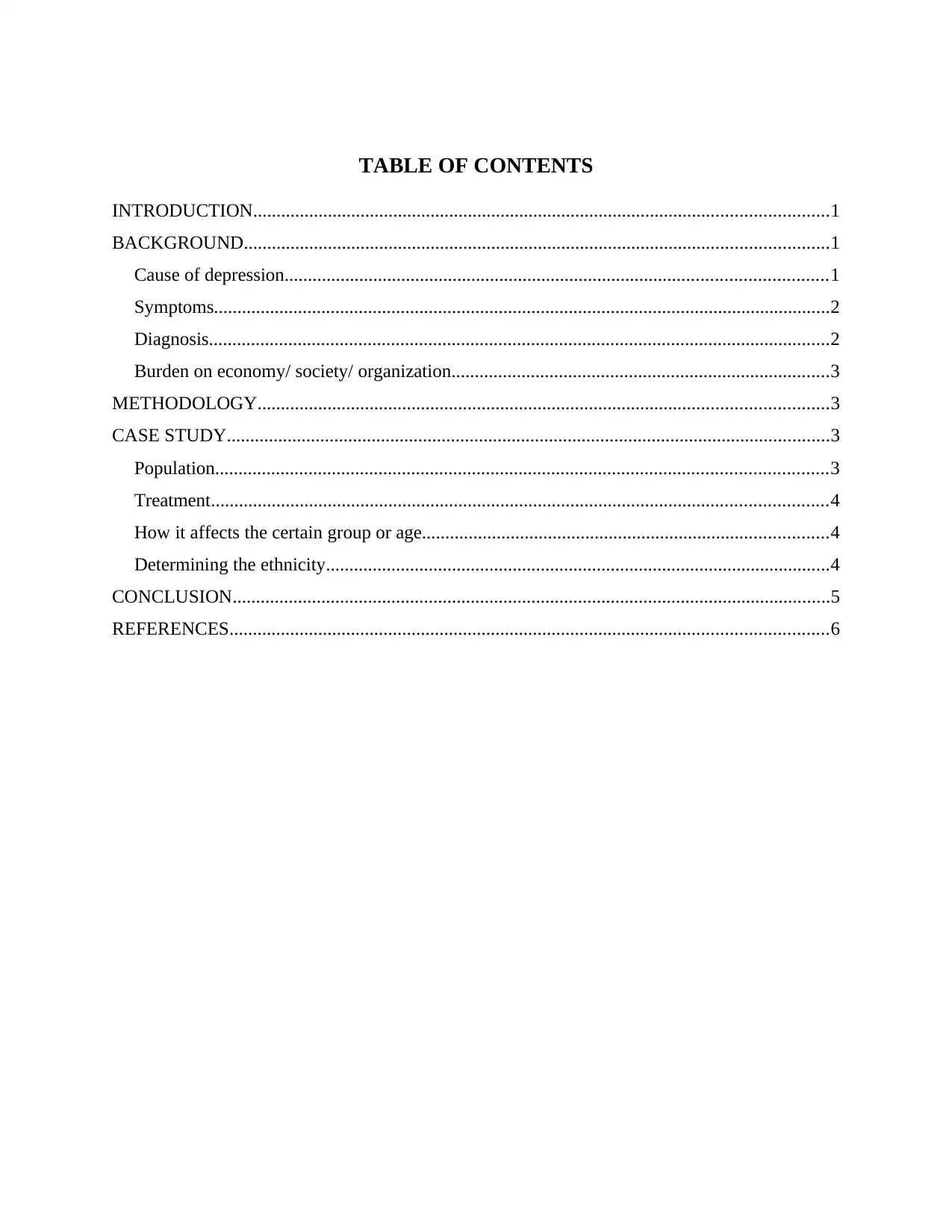
TABLE OF CONTENTS
INTRODUCTION...........................................................................................................................1
BACKGROUND.............................................................................................................................1
Cause of depression....................................................................................................................1
Symptoms....................................................................................................................................2
Diagnosis.....................................................................................................................................2
Burden on economy/ society/ organization.................................................................................3
METHODOLOGY..........................................................................................................................3
CASE STUDY.................................................................................................................................3
Population...................................................................................................................................3
Treatment....................................................................................................................................4
How it affects the certain group or age.......................................................................................4
Determining the ethnicity............................................................................................................4
CONCLUSION................................................................................................................................5
REFERENCES................................................................................................................................6
INTRODUCTION...........................................................................................................................1
BACKGROUND.............................................................................................................................1
Cause of depression....................................................................................................................1
Symptoms....................................................................................................................................2
Diagnosis.....................................................................................................................................2
Burden on economy/ society/ organization.................................................................................3
METHODOLOGY..........................................................................................................................3
CASE STUDY.................................................................................................................................3
Population...................................................................................................................................3
Treatment....................................................................................................................................4
How it affects the certain group or age.......................................................................................4
Determining the ethnicity............................................................................................................4
CONCLUSION................................................................................................................................5
REFERENCES................................................................................................................................6
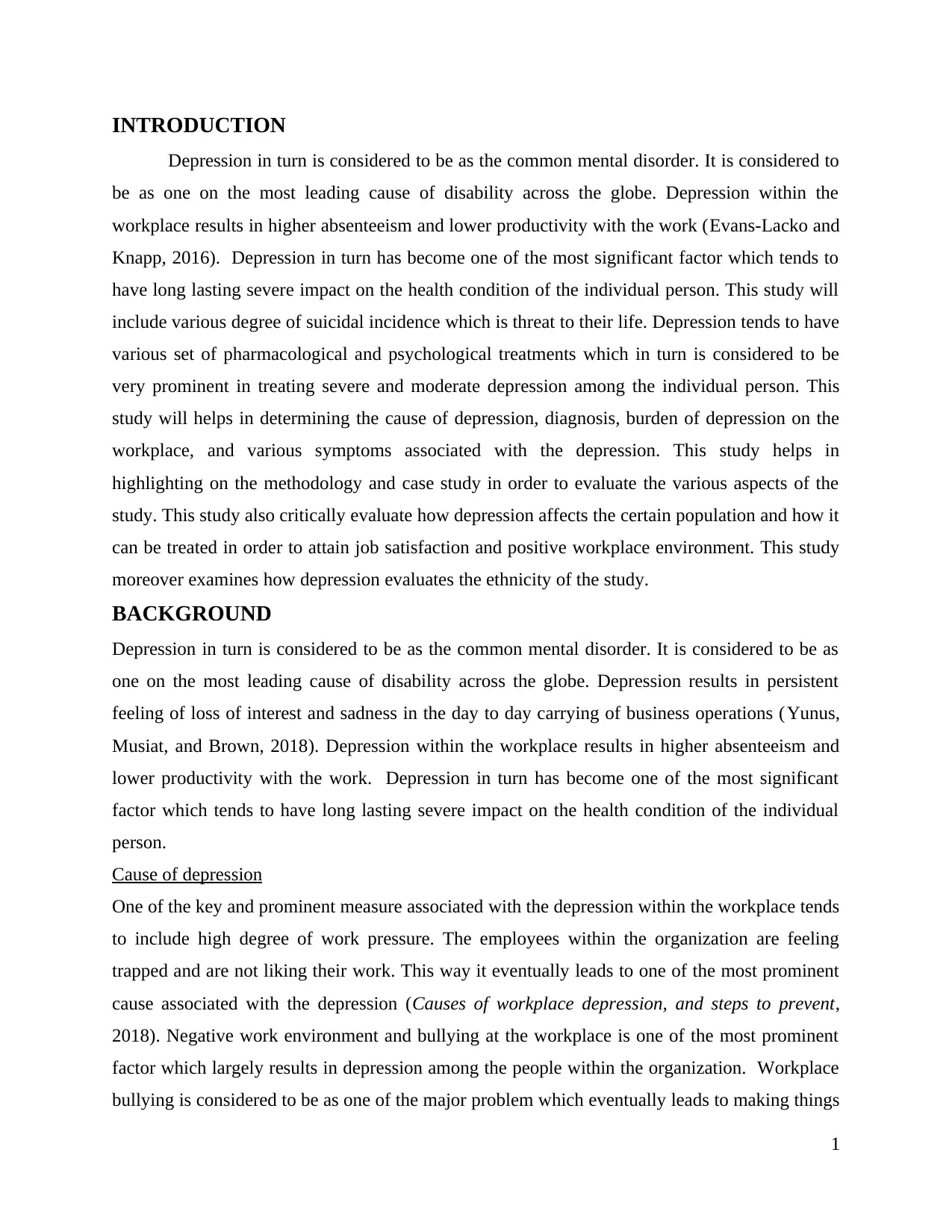
INTRODUCTION
Depression in turn is considered to be as the common mental disorder. It is considered to
be as one on the most leading cause of disability across the globe. Depression within the
workplace results in higher absenteeism and lower productivity with the work (Evans-Lacko and
Knapp, 2016). Depression in turn has become one of the most significant factor which tends to
have long lasting severe impact on the health condition of the individual person. This study will
include various degree of suicidal incidence which is threat to their life. Depression tends to have
various set of pharmacological and psychological treatments which in turn is considered to be
very prominent in treating severe and moderate depression among the individual person. This
study will helps in determining the cause of depression, diagnosis, burden of depression on the
workplace, and various symptoms associated with the depression. This study helps in
highlighting on the methodology and case study in order to evaluate the various aspects of the
study. This study also critically evaluate how depression affects the certain population and how it
can be treated in order to attain job satisfaction and positive workplace environment. This study
moreover examines how depression evaluates the ethnicity of the study.
BACKGROUND
Depression in turn is considered to be as the common mental disorder. It is considered to be as
one on the most leading cause of disability across the globe. Depression results in persistent
feeling of loss of interest and sadness in the day to day carrying of business operations (Yunus,
Musiat, and Brown, 2018). Depression within the workplace results in higher absenteeism and
lower productivity with the work. Depression in turn has become one of the most significant
factor which tends to have long lasting severe impact on the health condition of the individual
person.
Cause of depression
One of the key and prominent measure associated with the depression within the workplace tends
to include high degree of work pressure. The employees within the organization are feeling
trapped and are not liking their work. This way it eventually leads to one of the most prominent
cause associated with the depression (Causes of workplace depression, and steps to prevent,
2018). Negative work environment and bullying at the workplace is one of the most prominent
factor which largely results in depression among the people within the organization. Workplace
bullying is considered to be as one of the major problem which eventually leads to making things
1
Depression in turn is considered to be as the common mental disorder. It is considered to
be as one on the most leading cause of disability across the globe. Depression within the
workplace results in higher absenteeism and lower productivity with the work (Evans-Lacko and
Knapp, 2016). Depression in turn has become one of the most significant factor which tends to
have long lasting severe impact on the health condition of the individual person. This study will
include various degree of suicidal incidence which is threat to their life. Depression tends to have
various set of pharmacological and psychological treatments which in turn is considered to be
very prominent in treating severe and moderate depression among the individual person. This
study will helps in determining the cause of depression, diagnosis, burden of depression on the
workplace, and various symptoms associated with the depression. This study helps in
highlighting on the methodology and case study in order to evaluate the various aspects of the
study. This study also critically evaluate how depression affects the certain population and how it
can be treated in order to attain job satisfaction and positive workplace environment. This study
moreover examines how depression evaluates the ethnicity of the study.
BACKGROUND
Depression in turn is considered to be as the common mental disorder. It is considered to be as
one on the most leading cause of disability across the globe. Depression results in persistent
feeling of loss of interest and sadness in the day to day carrying of business operations (Yunus,
Musiat, and Brown, 2018). Depression within the workplace results in higher absenteeism and
lower productivity with the work. Depression in turn has become one of the most significant
factor which tends to have long lasting severe impact on the health condition of the individual
person.
Cause of depression
One of the key and prominent measure associated with the depression within the workplace tends
to include high degree of work pressure. The employees within the organization are feeling
trapped and are not liking their work. This way it eventually leads to one of the most prominent
cause associated with the depression (Causes of workplace depression, and steps to prevent,
2018). Negative work environment and bullying at the workplace is one of the most prominent
factor which largely results in depression among the people within the organization. Workplace
bullying is considered to be as one of the major problem which eventually leads to making things
1
⊘ This is a preview!⊘
Do you want full access?
Subscribe today to unlock all pages.

Trusted by 1+ million students worldwide
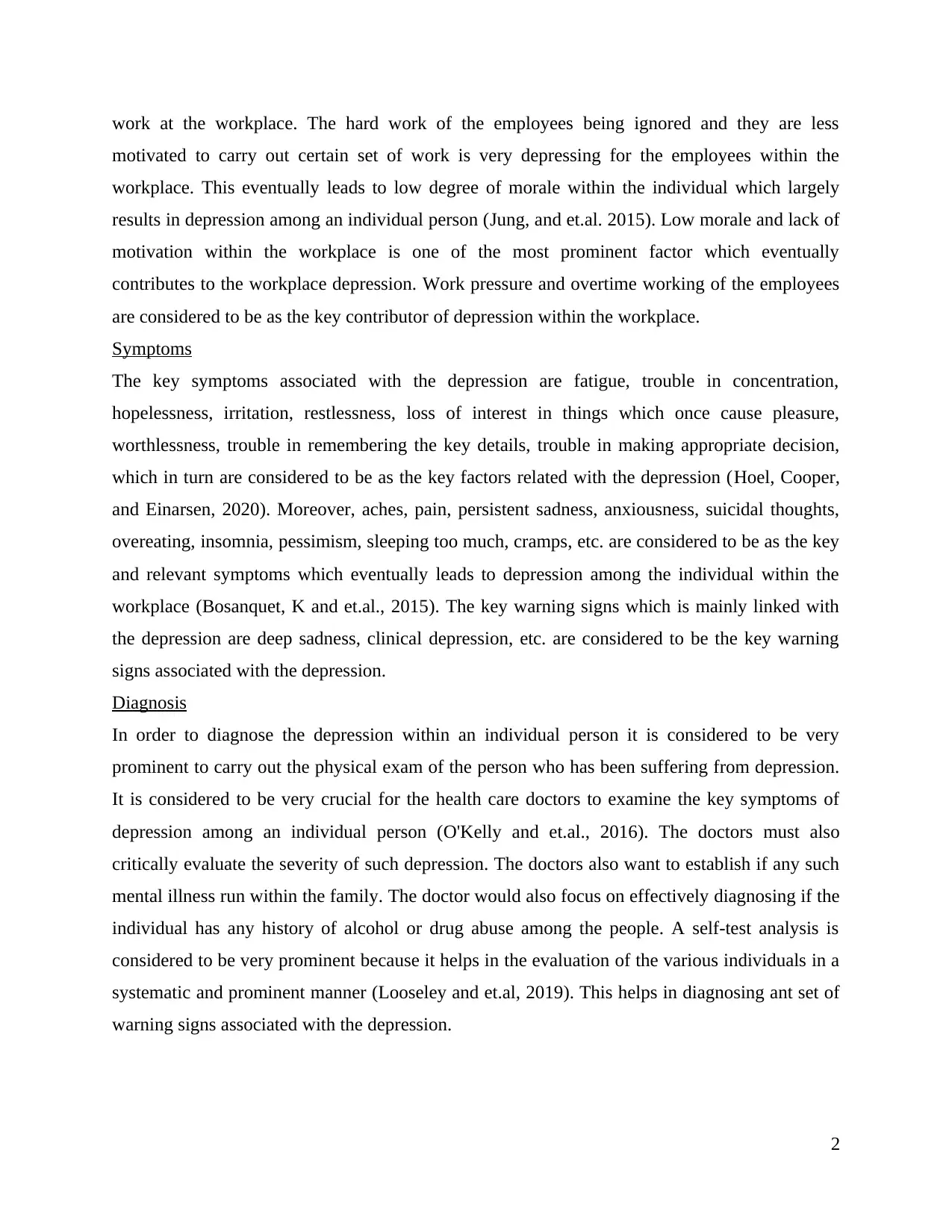
work at the workplace. The hard work of the employees being ignored and they are less
motivated to carry out certain set of work is very depressing for the employees within the
workplace. This eventually leads to low degree of morale within the individual which largely
results in depression among an individual person (Jung, and et.al. 2015). Low morale and lack of
motivation within the workplace is one of the most prominent factor which eventually
contributes to the workplace depression. Work pressure and overtime working of the employees
are considered to be as the key contributor of depression within the workplace.
Symptoms
The key symptoms associated with the depression are fatigue, trouble in concentration,
hopelessness, irritation, restlessness, loss of interest in things which once cause pleasure,
worthlessness, trouble in remembering the key details, trouble in making appropriate decision,
which in turn are considered to be as the key factors related with the depression (Hoel, Cooper,
and Einarsen, 2020). Moreover, aches, pain, persistent sadness, anxiousness, suicidal thoughts,
overeating, insomnia, pessimism, sleeping too much, cramps, etc. are considered to be as the key
and relevant symptoms which eventually leads to depression among the individual within the
workplace (Bosanquet, K and et.al., 2015). The key warning signs which is mainly linked with
the depression are deep sadness, clinical depression, etc. are considered to be the key warning
signs associated with the depression.
Diagnosis
In order to diagnose the depression within an individual person it is considered to be very
prominent to carry out the physical exam of the person who has been suffering from depression.
It is considered to be very crucial for the health care doctors to examine the key symptoms of
depression among an individual person (O'Kelly and et.al., 2016). The doctors must also
critically evaluate the severity of such depression. The doctors also want to establish if any such
mental illness run within the family. The doctor would also focus on effectively diagnosing if the
individual has any history of alcohol or drug abuse among the people. A self-test analysis is
considered to be very prominent because it helps in the evaluation of the various individuals in a
systematic and prominent manner (Looseley and et.al, 2019). This helps in diagnosing ant set of
warning signs associated with the depression.
2
motivated to carry out certain set of work is very depressing for the employees within the
workplace. This eventually leads to low degree of morale within the individual which largely
results in depression among an individual person (Jung, and et.al. 2015). Low morale and lack of
motivation within the workplace is one of the most prominent factor which eventually
contributes to the workplace depression. Work pressure and overtime working of the employees
are considered to be as the key contributor of depression within the workplace.
Symptoms
The key symptoms associated with the depression are fatigue, trouble in concentration,
hopelessness, irritation, restlessness, loss of interest in things which once cause pleasure,
worthlessness, trouble in remembering the key details, trouble in making appropriate decision,
which in turn are considered to be as the key factors related with the depression (Hoel, Cooper,
and Einarsen, 2020). Moreover, aches, pain, persistent sadness, anxiousness, suicidal thoughts,
overeating, insomnia, pessimism, sleeping too much, cramps, etc. are considered to be as the key
and relevant symptoms which eventually leads to depression among the individual within the
workplace (Bosanquet, K and et.al., 2015). The key warning signs which is mainly linked with
the depression are deep sadness, clinical depression, etc. are considered to be the key warning
signs associated with the depression.
Diagnosis
In order to diagnose the depression within an individual person it is considered to be very
prominent to carry out the physical exam of the person who has been suffering from depression.
It is considered to be very crucial for the health care doctors to examine the key symptoms of
depression among an individual person (O'Kelly and et.al., 2016). The doctors must also
critically evaluate the severity of such depression. The doctors also want to establish if any such
mental illness run within the family. The doctor would also focus on effectively diagnosing if the
individual has any history of alcohol or drug abuse among the people. A self-test analysis is
considered to be very prominent because it helps in the evaluation of the various individuals in a
systematic and prominent manner (Looseley and et.al, 2019). This helps in diagnosing ant set of
warning signs associated with the depression.
2
Paraphrase This Document
Need a fresh take? Get an instant paraphrase of this document with our AI Paraphraser
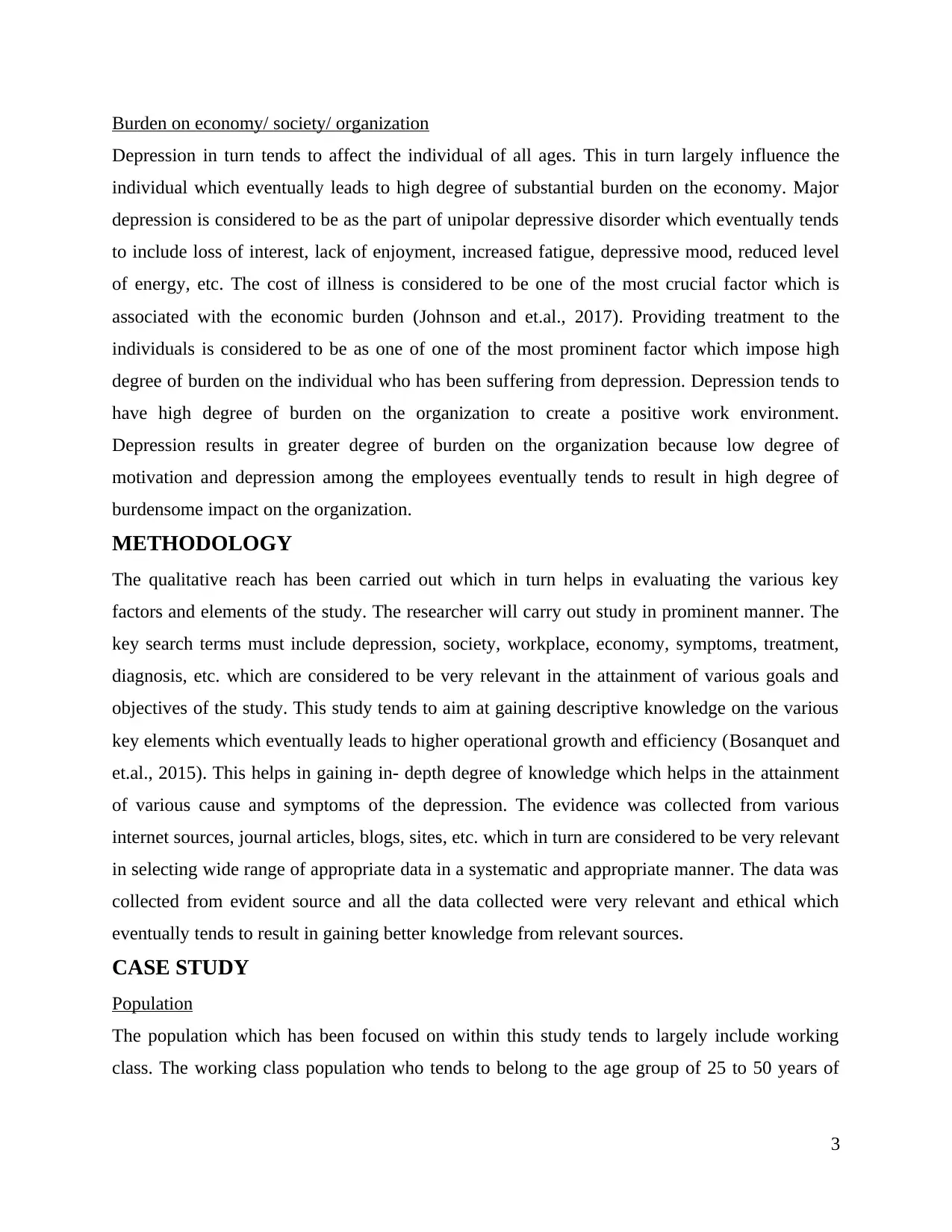
Burden on economy/ society/ organization
Depression in turn tends to affect the individual of all ages. This in turn largely influence the
individual which eventually leads to high degree of substantial burden on the economy. Major
depression is considered to be as the part of unipolar depressive disorder which eventually tends
to include loss of interest, lack of enjoyment, increased fatigue, depressive mood, reduced level
of energy, etc. The cost of illness is considered to be one of the most crucial factor which is
associated with the economic burden (Johnson and et.al., 2017). Providing treatment to the
individuals is considered to be as one of one of the most prominent factor which impose high
degree of burden on the individual who has been suffering from depression. Depression tends to
have high degree of burden on the organization to create a positive work environment.
Depression results in greater degree of burden on the organization because low degree of
motivation and depression among the employees eventually tends to result in high degree of
burdensome impact on the organization.
METHODOLOGY
The qualitative reach has been carried out which in turn helps in evaluating the various key
factors and elements of the study. The researcher will carry out study in prominent manner. The
key search terms must include depression, society, workplace, economy, symptoms, treatment,
diagnosis, etc. which are considered to be very relevant in the attainment of various goals and
objectives of the study. This study tends to aim at gaining descriptive knowledge on the various
key elements which eventually leads to higher operational growth and efficiency (Bosanquet and
et.al., 2015). This helps in gaining in- depth degree of knowledge which helps in the attainment
of various cause and symptoms of the depression. The evidence was collected from various
internet sources, journal articles, blogs, sites, etc. which in turn are considered to be very relevant
in selecting wide range of appropriate data in a systematic and appropriate manner. The data was
collected from evident source and all the data collected were very relevant and ethical which
eventually tends to result in gaining better knowledge from relevant sources.
CASE STUDY
Population
The population which has been focused on within this study tends to largely include working
class. The working class population who tends to belong to the age group of 25 to 50 years of
3
Depression in turn tends to affect the individual of all ages. This in turn largely influence the
individual which eventually leads to high degree of substantial burden on the economy. Major
depression is considered to be as the part of unipolar depressive disorder which eventually tends
to include loss of interest, lack of enjoyment, increased fatigue, depressive mood, reduced level
of energy, etc. The cost of illness is considered to be one of the most crucial factor which is
associated with the economic burden (Johnson and et.al., 2017). Providing treatment to the
individuals is considered to be as one of one of the most prominent factor which impose high
degree of burden on the individual who has been suffering from depression. Depression tends to
have high degree of burden on the organization to create a positive work environment.
Depression results in greater degree of burden on the organization because low degree of
motivation and depression among the employees eventually tends to result in high degree of
burdensome impact on the organization.
METHODOLOGY
The qualitative reach has been carried out which in turn helps in evaluating the various key
factors and elements of the study. The researcher will carry out study in prominent manner. The
key search terms must include depression, society, workplace, economy, symptoms, treatment,
diagnosis, etc. which are considered to be very relevant in the attainment of various goals and
objectives of the study. This study tends to aim at gaining descriptive knowledge on the various
key elements which eventually leads to higher operational growth and efficiency (Bosanquet and
et.al., 2015). This helps in gaining in- depth degree of knowledge which helps in the attainment
of various cause and symptoms of the depression. The evidence was collected from various
internet sources, journal articles, blogs, sites, etc. which in turn are considered to be very relevant
in selecting wide range of appropriate data in a systematic and appropriate manner. The data was
collected from evident source and all the data collected were very relevant and ethical which
eventually tends to result in gaining better knowledge from relevant sources.
CASE STUDY
Population
The population which has been focused on within this study tends to largely include working
class. The working class population who tends to belong to the age group of 25 to 50 years of
3

age. They are the key population who eventually tends to have key symptoms associated with the
depression.
Treatment
Cognitive behaviour therapy is considered to be as one of the most prominent measure which
helps in treating individuals with depression effectively. It helps in interacting more with the
people which helps in carrying out various range of activities effectively (Kaser, Zaman and
Sahakian, 2017). Cognitive behaviour therapy is considered to be as one of the most prominent
measure because it helps in reducing stress. Getting enough sleep, eating healthy and engaging in
exercise is considered to be as one of the most effective measure which helps in treating
individuals with depression within the workplace. Exercising regularly is considered to be as one
of the most effective measure which is very prominent in boosting up the chemicals which are
known as endorphins. Psychodynamic therapies is considered to be as one of the most effective
unconscious procedure which helps in manifesting the present behaviour of the client (Birks and
et.al., 2017). Psychodynamic therapy approach is considered to be very prominent because it
evaluate the understanding and awareness among the client. It also helps in influencing the
present and past behaviour of an individual person who has been going through depression.
Psychodynamic therapy includes a high degree of focus on understanding, expressing,
recognizing, acknowledging and overcoming various set of contradictory and negative feelings
which in turn helps in improving the patient's interpersonal relationships and experience
(Fluharty and et.al., 2016). Pharmacological treatment is also one of the most prominent factor
which helps in treating individuals with depression.
How it affects the certain group or age
Depression tends to affect the working group who belongs to of 25 to 50 years of age. They in
turn are highly affected by the depression at the workplace (Hoel, Cooper, and Einarsen, 2020).
Employee feeling trapped, negative work environment and bullying at the workplace, hard work
of the employees being ignored, etc. are considered to be as the key reason which results in
depression among employees within the organization. Work pressure, overtime working, low
motivation of the employees are considered to be as the key contributor of depression within the
workplace.
4
depression.
Treatment
Cognitive behaviour therapy is considered to be as one of the most prominent measure which
helps in treating individuals with depression effectively. It helps in interacting more with the
people which helps in carrying out various range of activities effectively (Kaser, Zaman and
Sahakian, 2017). Cognitive behaviour therapy is considered to be as one of the most prominent
measure because it helps in reducing stress. Getting enough sleep, eating healthy and engaging in
exercise is considered to be as one of the most effective measure which helps in treating
individuals with depression within the workplace. Exercising regularly is considered to be as one
of the most effective measure which is very prominent in boosting up the chemicals which are
known as endorphins. Psychodynamic therapies is considered to be as one of the most effective
unconscious procedure which helps in manifesting the present behaviour of the client (Birks and
et.al., 2017). Psychodynamic therapy approach is considered to be very prominent because it
evaluate the understanding and awareness among the client. It also helps in influencing the
present and past behaviour of an individual person who has been going through depression.
Psychodynamic therapy includes a high degree of focus on understanding, expressing,
recognizing, acknowledging and overcoming various set of contradictory and negative feelings
which in turn helps in improving the patient's interpersonal relationships and experience
(Fluharty and et.al., 2016). Pharmacological treatment is also one of the most prominent factor
which helps in treating individuals with depression.
How it affects the certain group or age
Depression tends to affect the working group who belongs to of 25 to 50 years of age. They in
turn are highly affected by the depression at the workplace (Hoel, Cooper, and Einarsen, 2020).
Employee feeling trapped, negative work environment and bullying at the workplace, hard work
of the employees being ignored, etc. are considered to be as the key reason which results in
depression among employees within the organization. Work pressure, overtime working, low
motivation of the employees are considered to be as the key contributor of depression within the
workplace.
4
⊘ This is a preview!⊘
Do you want full access?
Subscribe today to unlock all pages.

Trusted by 1+ million students worldwide
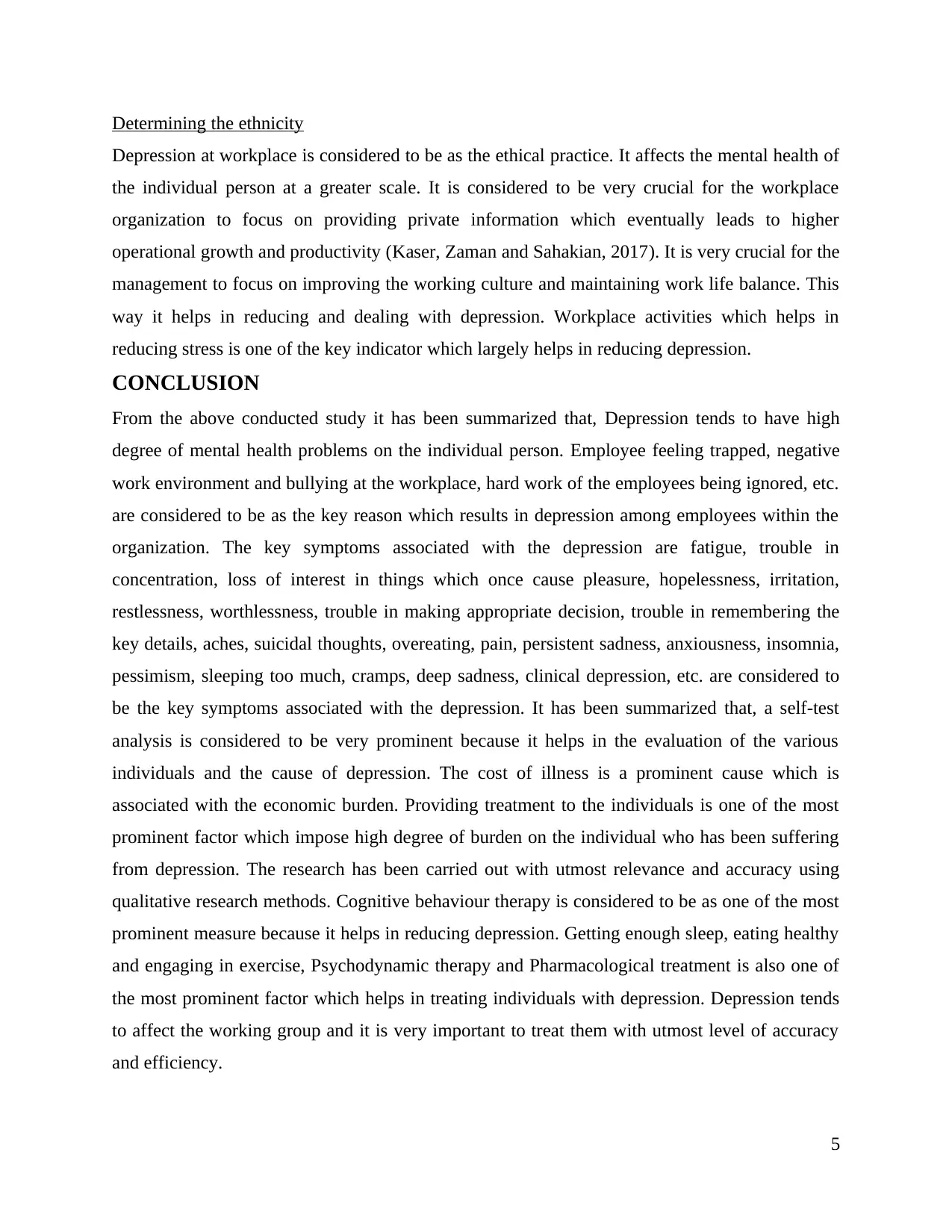
Determining the ethnicity
Depression at workplace is considered to be as the ethical practice. It affects the mental health of
the individual person at a greater scale. It is considered to be very crucial for the workplace
organization to focus on providing private information which eventually leads to higher
operational growth and productivity (Kaser, Zaman and Sahakian, 2017). It is very crucial for the
management to focus on improving the working culture and maintaining work life balance. This
way it helps in reducing and dealing with depression. Workplace activities which helps in
reducing stress is one of the key indicator which largely helps in reducing depression.
CONCLUSION
From the above conducted study it has been summarized that, Depression tends to have high
degree of mental health problems on the individual person. Employee feeling trapped, negative
work environment and bullying at the workplace, hard work of the employees being ignored, etc.
are considered to be as the key reason which results in depression among employees within the
organization. The key symptoms associated with the depression are fatigue, trouble in
concentration, loss of interest in things which once cause pleasure, hopelessness, irritation,
restlessness, worthlessness, trouble in making appropriate decision, trouble in remembering the
key details, aches, suicidal thoughts, overeating, pain, persistent sadness, anxiousness, insomnia,
pessimism, sleeping too much, cramps, deep sadness, clinical depression, etc. are considered to
be the key symptoms associated with the depression. It has been summarized that, a self-test
analysis is considered to be very prominent because it helps in the evaluation of the various
individuals and the cause of depression. The cost of illness is a prominent cause which is
associated with the economic burden. Providing treatment to the individuals is one of the most
prominent factor which impose high degree of burden on the individual who has been suffering
from depression. The research has been carried out with utmost relevance and accuracy using
qualitative research methods. Cognitive behaviour therapy is considered to be as one of the most
prominent measure because it helps in reducing depression. Getting enough sleep, eating healthy
and engaging in exercise, Psychodynamic therapy and Pharmacological treatment is also one of
the most prominent factor which helps in treating individuals with depression. Depression tends
to affect the working group and it is very important to treat them with utmost level of accuracy
and efficiency.
5
Depression at workplace is considered to be as the ethical practice. It affects the mental health of
the individual person at a greater scale. It is considered to be very crucial for the workplace
organization to focus on providing private information which eventually leads to higher
operational growth and productivity (Kaser, Zaman and Sahakian, 2017). It is very crucial for the
management to focus on improving the working culture and maintaining work life balance. This
way it helps in reducing and dealing with depression. Workplace activities which helps in
reducing stress is one of the key indicator which largely helps in reducing depression.
CONCLUSION
From the above conducted study it has been summarized that, Depression tends to have high
degree of mental health problems on the individual person. Employee feeling trapped, negative
work environment and bullying at the workplace, hard work of the employees being ignored, etc.
are considered to be as the key reason which results in depression among employees within the
organization. The key symptoms associated with the depression are fatigue, trouble in
concentration, loss of interest in things which once cause pleasure, hopelessness, irritation,
restlessness, worthlessness, trouble in making appropriate decision, trouble in remembering the
key details, aches, suicidal thoughts, overeating, pain, persistent sadness, anxiousness, insomnia,
pessimism, sleeping too much, cramps, deep sadness, clinical depression, etc. are considered to
be the key symptoms associated with the depression. It has been summarized that, a self-test
analysis is considered to be very prominent because it helps in the evaluation of the various
individuals and the cause of depression. The cost of illness is a prominent cause which is
associated with the economic burden. Providing treatment to the individuals is one of the most
prominent factor which impose high degree of burden on the individual who has been suffering
from depression. The research has been carried out with utmost relevance and accuracy using
qualitative research methods. Cognitive behaviour therapy is considered to be as one of the most
prominent measure because it helps in reducing depression. Getting enough sleep, eating healthy
and engaging in exercise, Psychodynamic therapy and Pharmacological treatment is also one of
the most prominent factor which helps in treating individuals with depression. Depression tends
to affect the working group and it is very important to treat them with utmost level of accuracy
and efficiency.
5
Paraphrase This Document
Need a fresh take? Get an instant paraphrase of this document with our AI Paraphraser
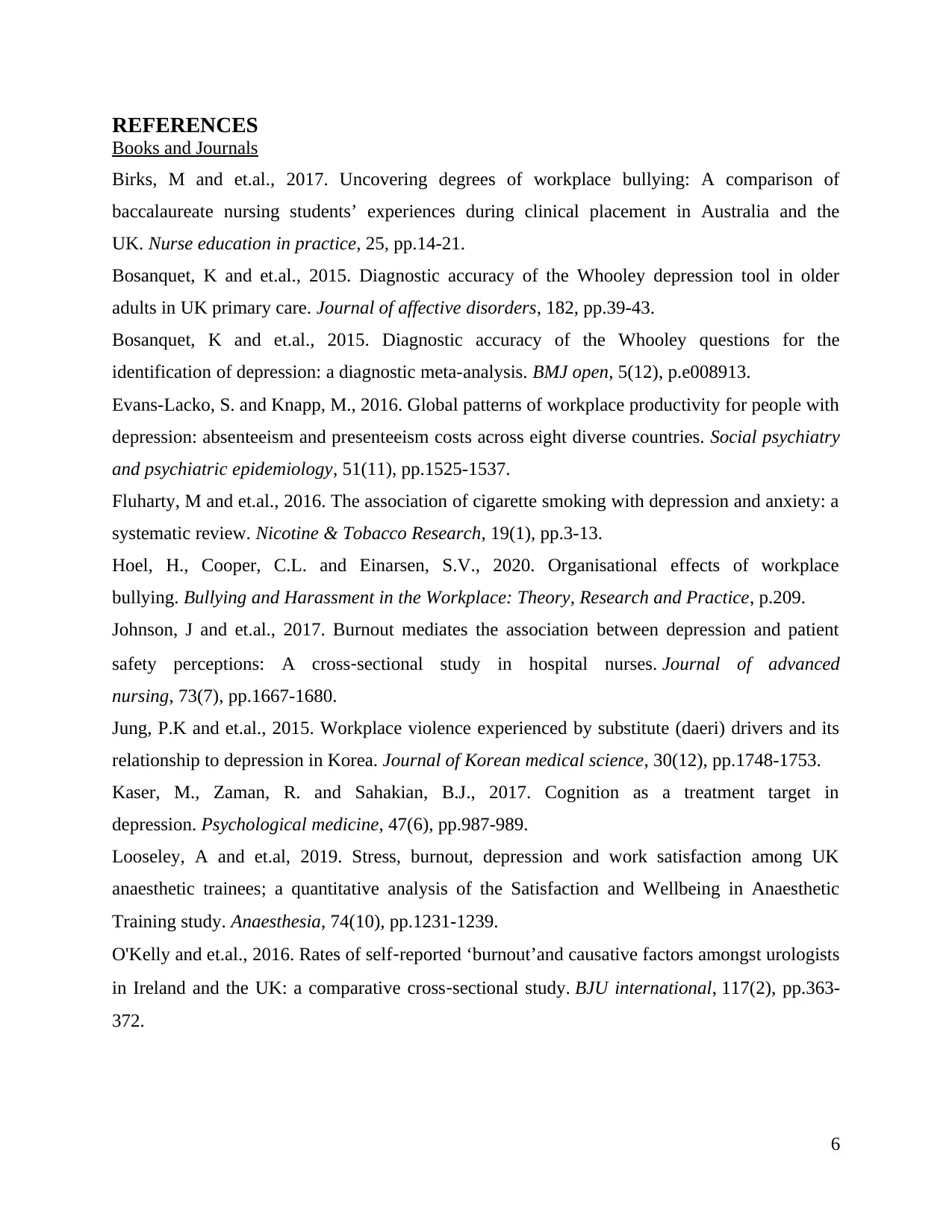
REFERENCES
Books and Journals
Birks, M and et.al., 2017. Uncovering degrees of workplace bullying: A comparison of
baccalaureate nursing students’ experiences during clinical placement in Australia and the
UK. Nurse education in practice, 25, pp.14-21.
Bosanquet, K and et.al., 2015. Diagnostic accuracy of the Whooley depression tool in older
adults in UK primary care. Journal of affective disorders, 182, pp.39-43.
Bosanquet, K and et.al., 2015. Diagnostic accuracy of the Whooley questions for the
identification of depression: a diagnostic meta-analysis. BMJ open, 5(12), p.e008913.
Evans-Lacko, S. and Knapp, M., 2016. Global patterns of workplace productivity for people with
depression: absenteeism and presenteeism costs across eight diverse countries. Social psychiatry
and psychiatric epidemiology, 51(11), pp.1525-1537.
Fluharty, M and et.al., 2016. The association of cigarette smoking with depression and anxiety: a
systematic review. Nicotine & Tobacco Research, 19(1), pp.3-13.
Hoel, H., Cooper, C.L. and Einarsen, S.V., 2020. Organisational effects of workplace
bullying. Bullying and Harassment in the Workplace: Theory, Research and Practice, p.209.
Johnson, J and et.al., 2017. Burnout mediates the association between depression and patient
safety perceptions: A cross‐sectional study in hospital nurses. Journal of advanced
nursing, 73(7), pp.1667-1680.
Jung, P.K and et.al., 2015. Workplace violence experienced by substitute (daeri) drivers and its
relationship to depression in Korea. Journal of Korean medical science, 30(12), pp.1748-1753.
Kaser, M., Zaman, R. and Sahakian, B.J., 2017. Cognition as a treatment target in
depression. Psychological medicine, 47(6), pp.987-989.
Looseley, A and et.al, 2019. Stress, burnout, depression and work satisfaction among UK
anaesthetic trainees; a quantitative analysis of the Satisfaction and Wellbeing in Anaesthetic
Training study. Anaesthesia, 74(10), pp.1231-1239.
O'Kelly and et.al., 2016. Rates of self‐reported ‘burnout’and causative factors amongst urologists
in Ireland and the UK: a comparative cross‐sectional study. BJU international, 117(2), pp.363-
372.
6
Books and Journals
Birks, M and et.al., 2017. Uncovering degrees of workplace bullying: A comparison of
baccalaureate nursing students’ experiences during clinical placement in Australia and the
UK. Nurse education in practice, 25, pp.14-21.
Bosanquet, K and et.al., 2015. Diagnostic accuracy of the Whooley depression tool in older
adults in UK primary care. Journal of affective disorders, 182, pp.39-43.
Bosanquet, K and et.al., 2015. Diagnostic accuracy of the Whooley questions for the
identification of depression: a diagnostic meta-analysis. BMJ open, 5(12), p.e008913.
Evans-Lacko, S. and Knapp, M., 2016. Global patterns of workplace productivity for people with
depression: absenteeism and presenteeism costs across eight diverse countries. Social psychiatry
and psychiatric epidemiology, 51(11), pp.1525-1537.
Fluharty, M and et.al., 2016. The association of cigarette smoking with depression and anxiety: a
systematic review. Nicotine & Tobacco Research, 19(1), pp.3-13.
Hoel, H., Cooper, C.L. and Einarsen, S.V., 2020. Organisational effects of workplace
bullying. Bullying and Harassment in the Workplace: Theory, Research and Practice, p.209.
Johnson, J and et.al., 2017. Burnout mediates the association between depression and patient
safety perceptions: A cross‐sectional study in hospital nurses. Journal of advanced
nursing, 73(7), pp.1667-1680.
Jung, P.K and et.al., 2015. Workplace violence experienced by substitute (daeri) drivers and its
relationship to depression in Korea. Journal of Korean medical science, 30(12), pp.1748-1753.
Kaser, M., Zaman, R. and Sahakian, B.J., 2017. Cognition as a treatment target in
depression. Psychological medicine, 47(6), pp.987-989.
Looseley, A and et.al, 2019. Stress, burnout, depression and work satisfaction among UK
anaesthetic trainees; a quantitative analysis of the Satisfaction and Wellbeing in Anaesthetic
Training study. Anaesthesia, 74(10), pp.1231-1239.
O'Kelly and et.al., 2016. Rates of self‐reported ‘burnout’and causative factors amongst urologists
in Ireland and the UK: a comparative cross‐sectional study. BJU international, 117(2), pp.363-
372.
6

Yunus, W.M.A.W.M., Musiat, P. and Brown, J.S., 2018. Systematic review of universal and
targeted workplace interventions for depression. Occupational and environmental
medicine, 75(1), pp.66-75.
Online
Causes of workplace depression, and steps to prevent. 2018. [ONLINE]. Available through<
https://www.ishn.com/articles/108571-causes-of-workplace-depression-and-steps-to-prevent>
7
targeted workplace interventions for depression. Occupational and environmental
medicine, 75(1), pp.66-75.
Online
Causes of workplace depression, and steps to prevent. 2018. [ONLINE]. Available through<
https://www.ishn.com/articles/108571-causes-of-workplace-depression-and-steps-to-prevent>
7
⊘ This is a preview!⊘
Do you want full access?
Subscribe today to unlock all pages.

Trusted by 1+ million students worldwide
1 out of 9
Related Documents
Your All-in-One AI-Powered Toolkit for Academic Success.
+13062052269
info@desklib.com
Available 24*7 on WhatsApp / Email
![[object Object]](/_next/static/media/star-bottom.7253800d.svg)
Unlock your academic potential
Copyright © 2020–2025 A2Z Services. All Rights Reserved. Developed and managed by ZUCOL.





